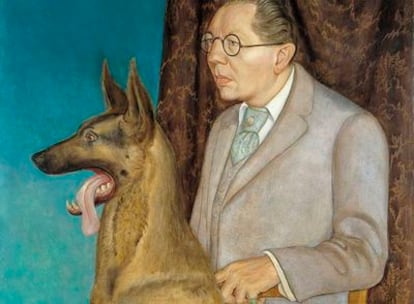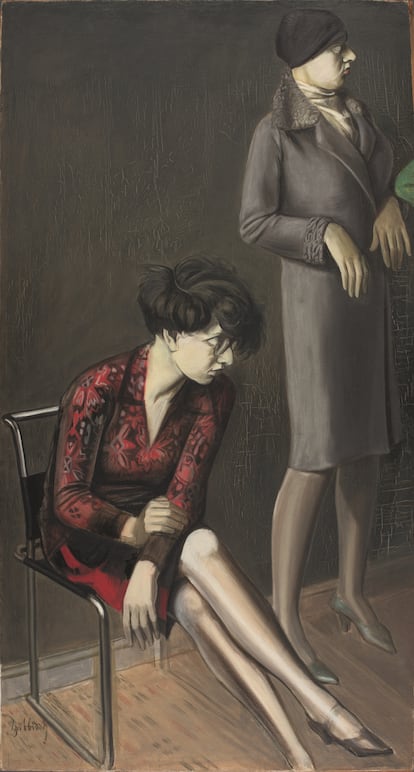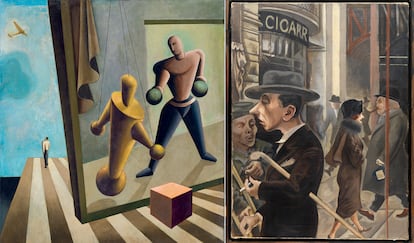It was one of the most turbulent periods in history. It was one of the most brilliant and creative stages in history. The Weimar Republic, the period of democratic parliamentarism in Germany between 1918 and 1933, lasted just 15 years, but what happened then, from politics to the design of a glass, marked the rest of the 20th century. For better and for worse. Of what Weimar gave of itself in arts, culture, science and philosophy; of cinema and photography as new media and new weapons for politics, of the plastic rupture of the avant-garde and of the flowering that united beauty and practice in the Bauhaus school, a broad overview is offered in the star exhibition of this season at the CaixaForum Madrid, Uncertain times. Germany between the wars.
This exhibition, which will be open until February 16, begins with the recreation of an old bourgeois salon, with its dances, slick manners and the certainty that nothing was going to change, a reference to the novel by Thomas Mann Los Buddenbrook. In that room you hear The Rite of Spring, by Stravinsky, who anticipates the horror to come. Immediately, you walk through a disturbing hallway between two high walls that represent a trench. Several illuminated messages remember what the First World War was like, with its 10 million dead soldiers. The German Empire emerged defeated and humiliated from that conflict. A confusion that the social democrats took advantage of to proclaim the Republic, with its epicenter in the city cradle of the German Enlightenment in the 18th century, Weimar, where Goethe and Schiller had resided. An idea of renewal based on reason and equality (for the first time women were able to vote).
The arts began to reflect what the birth of that brand new society was like, with its new forms of expression, such as cinema. In a cube that surrounds the visitor you can see fragments of the jewels of German expressionism, such as Metropolis (1927), by Fritz Lang, with its message that the individual has dissolved into the mass to follow a leader; either Dr. Caligari’s office (1920), from Robert Wiene, on the individual without will. Also, the filming of the masses in the streets in the November revolution, from which Weimar was born. “It is a moment in which certainties are questioned and conflict is entered into with what has gone before,” said one of the two curators of the exhibition, Pau Pedragosa.
If you turn around, half a dozen of August Sander’s extraordinary portraits of German society appear, from the artist to the proletarian, from the charcoal burner to the bourgeois, which made up his ambitious documentary project. Men of the 20th century. Sander was one of the artists who would suffer the rise to power of the Nazis: his son, a socialist, was sentenced to prison, and plates of his photographic work were destroyed.
The exhibition has loans from the Thyssen-Bornemisza National Museum, the National Museum of Decorative Arts, the Institut Valencià d’Art Modern (IVAM) and German institutions such as the Stadtmuseum and the Georg Kolbe Museum, both in Berlin (totaling around ninety works of art). The emergence of the press also has its space, with the magazine covers BEHIND (Illustrated Workers’ Newspaper), a weekly newspaper that was published between 1924 and 1938 and whose taste for the photomontage technique can be seen to criticize, on the one hand, the embers of the old Prussian regime, and on the other, the Nazis (the National Socialist Party had been founded in February 1919).

Precisely, latent in the tour is the threat that the Weimar Republic could explode at any moment. The payment of debts due to the world war and hyperinflation collapsed the system in 1923 and populated the streets of Berlin with homeless people. In November of that year Adolf Hitler, already leader of the Nazi Party, led the Brewery Putsch, a failed coup d’état in Munich to end the Republic, which survived thanks to a social economic policy, with a new large bank and a new currency.
Furthermore, it was the door to a period of economic growth and the roaring twenties, to the desire to enjoy at all costs. The times of cabaret and champagne that ended on the precipice of the crash of 1929. Opulence and poverty intersect in the streets, as shown in one of the jewels of the exhibition, the series of lithographs by the expressionist painter Georg Grosz, entitled The bandits, of 1922 (name taken from Schiller’s theatrical drama of 1871. Some drawings that forge the image of the exploiter: plump, with a cigar, bald and elegantly dressed. Grosz was one of the artists who mobilized on the left. His lithographs were accompanied of quotes from Schiller’s work. In one of them a rich man passes in front of a beggar who is on the ground and says: “I have already done my part… the looting is your business!”
If there is anything typical of that Republic, it is the Bauhaus school, founded by the architect Walter Gropius in Weimar in 1919. A center for artists, craftsmen, and designers in which communion between aesthetics and practical utility was sought. In a room we see examples of his chairs, lamps and teapots – so modern and from a century ago – along with works by Paul Klee, Vasili Kandinsky (Bauhaus professors), László Moholy Nagy and El Lissitzky, of whom several are shown. of the covers he designed for books. The Bauhaus was also in the crosshairs of Nazism until it was closed in July 1933.
Precisely, Pedragosa reflected, in the presentation to the press, how “uncertain times awaken monsters.” “It happened in 1924, when the extreme right won the elections in Thuringia (the region to which Weimar belongs) and since we are also in uncertain times, it has happened again” with the victory in Thuringia in September of the Alternative for Germany ultras

Returning to the historical narrative, after three general elections, in which no party was able to form a government, the president of the Republic, Hindenburg, still considered a hero of the Great War, appointed Hitler chancellor on January 30, 1933. A month later the Reichstag fire occurred, the burning of the German Parliament was used by Hitler to take repressive measures and eliminate rights. Another fire certified the death of the Weimar Republic. At the end of the exhibition is the filming of the night of May 10, 1933 in Berlin, the ghostly burning of some 40,000 books considered “anti-German”, thrown on the bonfire by young followers of the Nazi Party with Joseph Goebbels as master of the coven: “Here the (Weimar) Republic is destroyed. No to decadence and moral corruption!”

